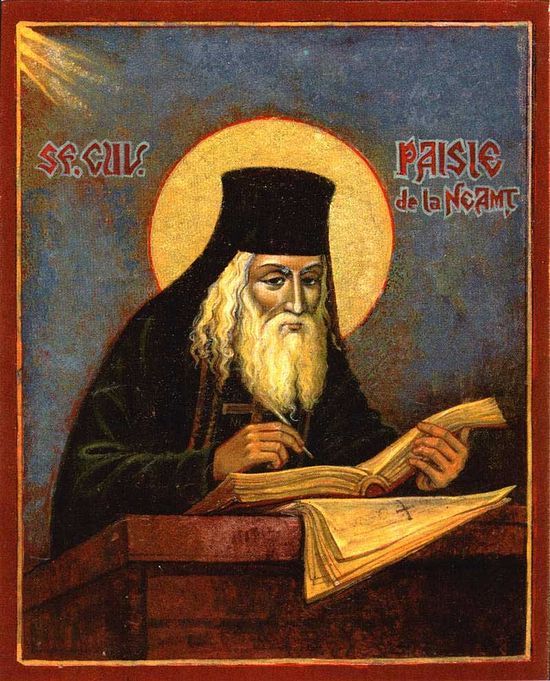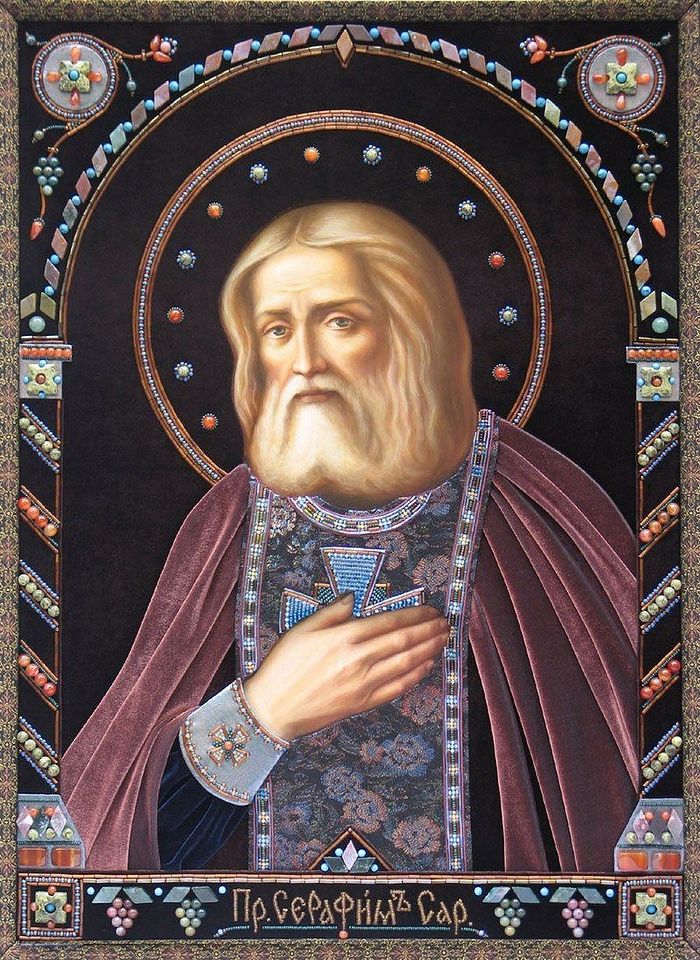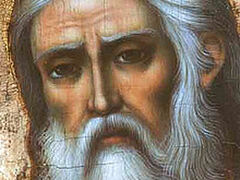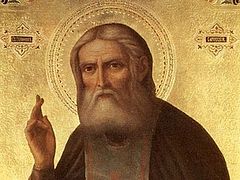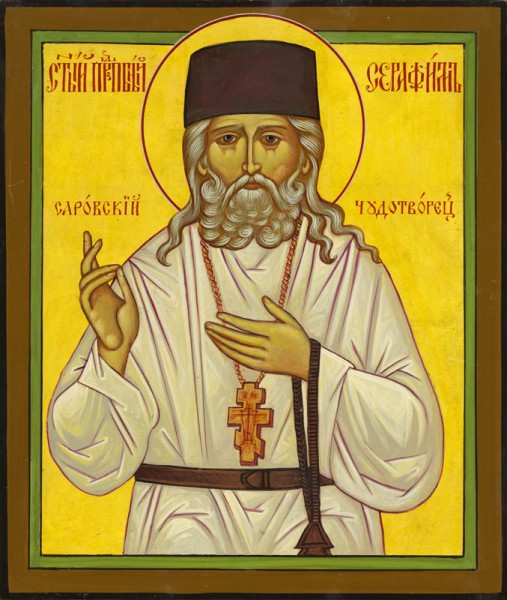
THE BEST KNOWN of the Orthodox saints of modern times, St. Seraphim of Sarov, has much to teach the Orthodox Christians of these last times. Unfortunately, the striking nature of some of his spiritual experiences—which indeed stand in glaring contrast to the ordinary Christian experience of our days—has led some to miss the whole point of his teaching. Some are so dazzled by his visions and his all-embracing love that they try to follow him into the most exalted spheres of spiritual life without even the most elementary foundation in Orthodox knowledge and practice; others try artificially to set his "spirituality" against the "institutionalized Church," as if the two could be separated; still others would make him to be a "charismatic" figure who justifies the empty ecumenical "spirituality" of our own poor days; and a few imagine him to be a "guru" whose experience places him "beyond Christianity" and all religious traditions.
All such interpretations—which only bring spiritual harm and disaster to those who follow them—fail to understand St. Seraphim in the context of the religious tradition that produced him as one of its greatest flowerings: Orthodox Christianity in eighteenth century Russia.
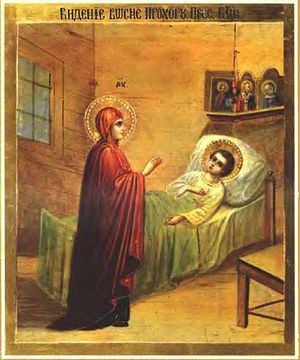 St. Seraphim (his worldly name was Prochor Moshnin) was born in 1754 in Kursk, in the heart of Holy Russia, to a pious merchant family. Raised in the fear of God and strict Orthodox life, he also knew very early the mercies of God at first hand; at the age of ten he was miraculously healed of a serious affliction by the Mother of God through her Kursk Icon (which is now in America and continues to work miracles).
St. Seraphim (his worldly name was Prochor Moshnin) was born in 1754 in Kursk, in the heart of Holy Russia, to a pious merchant family. Raised in the fear of God and strict Orthodox life, he also knew very early the mercies of God at first hand; at the age of ten he was miraculously healed of a serious affliction by the Mother of God through her Kursk Icon (which is now in America and continues to work miracles).
Once he learned to read, the boy Prochor immersed himself in the spiritual world of basic Christian literature: the Scriptures, the Horologion (containing the daily cycle of church services), the Psalter, and the Lives of Saints. He spent all the time he could in church (where services would go on for many hours every day), and thought only of God and the spiritual world. A deep desire for spiritual things being thus kindled in him, he began to long to serve God in the monastic calling. At the age of nineteen, on a pilgrimage to the holy places of Kiev, he received the counsel of the holy recluse Dositheus (actually a woman) to "go to Sarov"; and after a short time this is what he did—spending the rest of his life in this remarkable Monastery.
The Hermitage of Sarov had been founded early in the eighteenth century by the Elder John. The first settlers here were cave dwellers, and the Monastery always remained a place of severe ascetic life, at the same time handing down the ancient monastic tradition of inward spiritual activity, the mental prayer of Jesus. Eighteenth century Russia, although it was a time of monastic decline when compared with the flowering of the fourteenth to the seventeenth centuries, still had a number of fathers (and mothers) who kept alive the ancient tradition of Christian spirituality. The great monastic revival inspired by the great Elder Paisius Velichkovsky and his disciples at the end of the eighteenth century produced such remarkable spiritual fruits (notably the clairvoyant Elders of Optina Monastery) precisely because the Russian soil had been prepared beforehand by an unbroken tradition of monastic struggle and spiritual life.
Blessed Paisius translated the patristic texts on spiritual life, most notably the anthology known as the Philokalia. St. Seraphim made use of this book, which he probably received from Elder Nazarius of Sarov, one of the spiritual elders who prepared its publication; but the Philokalia was published in 1794, and St. Seraphim was spiritually formed before this, having read numerous other patristic books that taught the same spiritual doctrine. There is nothing whatever that is "new" in the spiritual face of St. Seraphim; all is from the Holy Fathers, of whom he is a most faithful disciple, appearing in the latter times like some great desert Father of antiquity, like a new St. Macarius the Great.
In Sarov, Sr. Seraphim went through the standard monastic period of trial: he was placed in obedience to a spiritual father and was tested at various labors in the bread and prosphora bakeries, the carpenter shop, at chopping wood, as candlelighter. Church services were long, as was his cell rule of prayer. In addition to the difficult monastic discipline, he was severely ill for three years—a trial he bore with humility and trust in God—until being healed by a vision of the Mother of God.
At the age of twenty-seven St. Seraphim was tonsured a monk, and a few months later was ordained deacon. He served as deacon for nearly seven years, entering deeply into the meaning of the Church's services. Often he saw angels; and once, on Great Thursday, as he stood before the Royal Doors in the middle of the Liturgy, he saw Christ Himself in the air surrounded by angels. Unable to continue serving, he was conducted away and stood for several hours in ecstasy.
At the age of thirty-four he was ordained priest, and the next year his elder, Abbot Pachomius, on his deathbed entrusted to St. Seraphim the spiritual guidance of the sisters of the nearby Diveyevo Convent—a task he fulfilled so well that even today, fifty years after it was destroyed[1], it is still remembered as "St. Seraphim's Diveyevo." Just at this time he also received the blessing of the new Abbot to begin life as a hermit in the forest around Sarov. Here in a small cabin he performed a long rule of prayer, labored much, and read the Scriptures and Holy Fathers. On Sundays he would come to the Monastery to attend the Liturgy and receive Holy Communion, returning to the forest with his supply of bread for the week. For one period of three years he ate nothing but a certain herb called "sneet."
In 1804 the saint was attacked by robbers and beaten almost to death. The Mother of God appeared to him in his affliction, together with the Apostles Peter and John the Theologian, saying of him: "This is one of our kind." After this attack he was bent over and walked always with a staff.
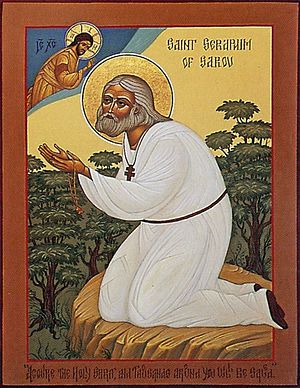 Now the saint undertook yet greater struggles. Returning to his forest desert, he undertook an exploit like that of the ancient pillar saints of Syria: for a thousand days and nights he spent the better part of his time kneeling on a stone not far from his cell, constantly calling out to God with the prayer of the publican: "O God, be merciful to me a sinner." Strengthened by divine grace for this humanly impossible task, he entered into open battle with the demons at this time, like St. Anthony of old in the tombs; often he would see the demons, whom he would only describe as "foul."
Now the saint undertook yet greater struggles. Returning to his forest desert, he undertook an exploit like that of the ancient pillar saints of Syria: for a thousand days and nights he spent the better part of his time kneeling on a stone not far from his cell, constantly calling out to God with the prayer of the publican: "O God, be merciful to me a sinner." Strengthened by divine grace for this humanly impossible task, he entered into open battle with the demons at this time, like St. Anthony of old in the tombs; often he would see the demons, whom he would only describe as "foul."
In 1807, his last elder and instructor, Abbot Isaiah, died; and the saint went into absolute seclusion, refusing to see anyone and maintaining an absolute silence for three years. He no longer came to the Monastery even for Divine Services on Sunday, enduring with patience the great cross of total isolation and silence, by which he yet more crucified the passions and lusts of the old man.
Some of the inexperienced brethren of the Monastery, however, became scandalized that the saint did not seem to be receiving Holy Communion; and the Monastery elders requested him to return (1810). In his monastery cell he remained in silence and seclusion, continuing just as in his forest cell to read the whole daily cycle of services, except for the Liturgy, saying the prayer of Jesus, and especially reading the New Testament (which he went through once a week). During this time he was granted visions of heavenly mysteries, beholding the mansions of heaven with many of the saints.
After five years of this seclusion within the Monastery, St. Seraphim, by a special revelation, opened the door of his cell for all who desired to see him; but still he continued his spiritual exercises without paying any attention to his visitors or answering their questions. After five more years the Mother of God again appeared to him, together with Sts. Onuphrius the Great and Peter of Mt. Athos, instructing hint to end his silence and speak for the benefit of others. Now he greeted all who came with a prostration, a kiss and the Paschal greeting: "Christ is risen!" Everyone he called "my joy." In 1825, the Mother of God again appeared to him and blessed him to return to his forest cell.
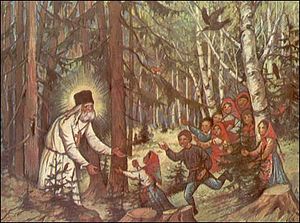 For the last eight years of his life St. Seraphim lived in the forest of Sarov and received the thousands of pilgrims who came to him to ask his prayers and spiritual counsel. The saint now was manifest as a clairvoyant wonderworker, a grace-filled vessel of the action of the Holy Spirit. No one—monk, layman, or nun (whether of Diveyevo or of the several other convents which arose with his blessing)—left him without consolation and an answer to their spiritual need. He was in constant contact with the world above; twelve times in all, the Mother of God Herself appeared to him. He died kneeling before an icon of the Mother of God of "Tender Feeling" on January 2, 1833.
For the last eight years of his life St. Seraphim lived in the forest of Sarov and received the thousands of pilgrims who came to him to ask his prayers and spiritual counsel. The saint now was manifest as a clairvoyant wonderworker, a grace-filled vessel of the action of the Holy Spirit. No one—monk, layman, or nun (whether of Diveyevo or of the several other convents which arose with his blessing)—left him without consolation and an answer to their spiritual need. He was in constant contact with the world above; twelve times in all, the Mother of God Herself appeared to him. He died kneeling before an icon of the Mother of God of "Tender Feeling" on January 2, 1833.
Having led a heavenly life on earth, like the great desert saints of antiquity, even in these latter times of spiritual desolation, St. Seraphim is an instructor and an inspirer of the true Christian life. His Spiritual Instructions—like his celebrated Conversation with Motovilov on the Acquisition of the Holy Spirit—contain no new teaching, but simply repeat in modern times the age-old Christian teaching of the great Fathers whom he constantly cites: Sts. Basil the Great, Gregory the Theologian, John Chrysostom, Macarius the Great, Dionysius the Areopagite, Ambrose of Milan, Isaac the Syrian, Symeon the New Theologian, the Fathers of the Philokalia. These, with the Holy Scriptures, the Lives of Saints, and the Church services—all in the context of the living Sarov tradition of spiritual life—are his sources, and he is a faithful transmitter of their teaching: fear of God; heedfulness to oneself; not trusting the impulses of one's own heart but becoming so immersed in God's word that one learns to "swim in the law of the Lord"; working out one's salvation with patience, humility, repentance, forgiveness; acquiring the Spirit of peace, the Holy Spirit, which is the end of all our spiritual labors; placing first God and His love, which kindles our cold hearts and inspires us to follow Him, to know and to love Him. This teaching is not complex; but in our own days, when the love of many has grown cold and the salt is going out of Christianity, it is almost impossible to follow. Only with great humility on our part—which we can learn from the profound humility of "poor Seraphim," as he called himself—can we hope to receive and apply this teaching of the true Christian spiritual life to our own poor Christian lives.
By the prayers of our holy Father Seraphim, may we understand his words and practice them, according to our strength, for the salvation of our souls!
* * *
Originally published as the introduction to Little Russian Philokalia Vol. 1: St. Seraphim of Sarov, St. Herman Press (2008), pp. 13-17.

